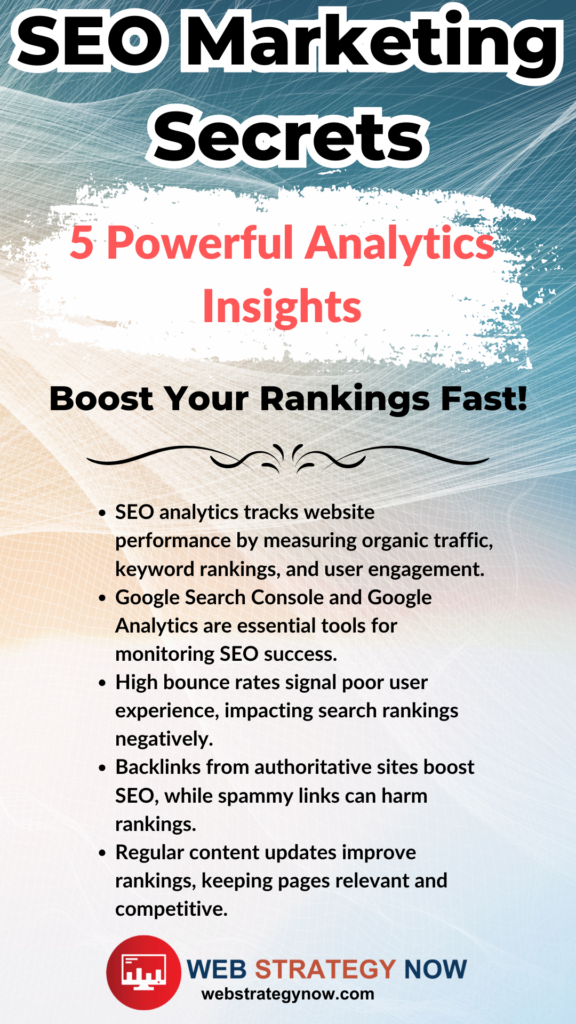Affiliate Disclaimer: This post contains affiliate links. If you purchase through them, I may earn a commission at no extra cost to you.
SEO isn’t magic—it’s math. If you don’t measure what’s working and what’s failing, you’re wasting time, money, and potential revenue. That’s why tracking SEO performance is the foundation of any successful SEO strategy. It tells you exactly what’s driving traffic, where your efforts are falling short, and how to adjust for better results.

If you’re running an e-commerce website, the stakes are even higher. Organic traffic isn’t just about visibility—it’s about conversions, revenue, and long-term business growth. That’s why SEO web analytics and SEO technical analysis are non-negotiable. Without them, you’re guessing. And in digital marketing, guessing means losing.
Let’s dive into the essential methods, tools, and strategies that will help you track, analyze, and improve your SEO performance so your site ranks higher, attracts more visitors, and converts them into paying customers.
Why Tracking SEO Performance Is Essential for E-Commerce
Too many website owners create content, optimize for keywords, and then… hope for the best. The problem? SEO is not a “set it and forget it” game. It’s a continuous process of testing, tracking, and refining.
Without proper tracking, you’ll never know:
- Which keywords are bringing the most qualified visitors to your site.
- Where users are dropping off before making a purchase.
- How your backlinks impact search rankings.
- Whether technical SEO issues are hurting your visibility.
By implementing SEO web analytics, you gain access to hard data that shows exactly where your strengths and weaknesses lie. That means better decision-making, faster growth, and higher conversions.
1. How to Track Organic Traffic the Right Way
The first metric for tracking SEO performance that you need to monitor is organic traffic—the number of visitors landing on your site through search engines. If your organic traffic is growing, it means your SEO efforts are working. If it’s declining, something needs to be fixed—fast.
Key Tools for Tracking Organic Traffic
- Google Analytics – Navigate to the “Acquisition” tab to see how much traffic is coming from organic search.
- Google Search Console – Provides insights into impressions, clicks, and keyword performance.
- Keyword Tracking Tools – A keyword tool like this can help you track rankings for important search terms.
If you see a drop in traffic, don’t panic. Instead, ask:
- Did Google release a new algorithm update?
- Are competitors outranking you?
- Has your site experienced technical issues (like slow loading speed or broken links)?
Understanding why traffic fluctuates helps you take the right action to recover and improve.
2. Technical SEO: The Hidden Factor in Search Rankings
Many website owners focus only on content and backlinks while ignoring technical SEO—a crucial element of tracking SEO performance. Even if you have the best content in your niche, poor site structure, slow load times, and mobile issues can kill your rankings.
Essential Technical Analysis Tips
✔ Crawl Your Site – Use tools like Screaming Frog or Sitebulb to find errors like broken links and duplicate content.
✔ Check for Indexing Issues – Make sure Google is crawling and indexing your pages properly.
✔ Improve Website Speed – Use Google’s PageSpeed Insights to identify slow-loading elements.
✔ Optimize for Mobile – Google prioritizes mobile-first indexing, so your site must be mobile-friendly.
Want to learn simple fixes for technical SEO? Check out this Technical SEO Guide to improve rankings quickly.
3. Keyword Tracking: Find Out Which Terms Drive Traffic
Keywords are the backbone of your SEO strategy. But simply choosing keywords isn’t enough—you need to monitor them to see what’s driving traffic and what’s losing ground.
How to Track Keyword Performance
- Google Search Console – Shows which keywords bring in clicks and impressions.
- Rank Tracking Software – Use a keyword tool like this to monitor ranking changes over time.
- Competitor Analysis – Find out which keywords your competitors rank for and adjust your strategy.
If your keyword rankings are dropping, it might mean:
- You need fresh content updates.
- Your competitors have stronger backlinks.
- Your page isn’t optimized for search intent.
This is why SEO is a continuous process. You must keep tracking, testing, and tweaking your strategy.
4. Backlink Analysis: Are Your Links Helping or Hurting You?
Backlinks are a huge ranking factor, but many website owners don’t track them properly. Just because you have 100 backlinks doesn’t mean they’re helping your rankings—some could be doing more harm than good.
How to Monitor Backlinks Effectively
- Google Search Console – See which websites link to you.
- Backlink Audit Tools – Check Moz, Ahrefs, or Majestic to analyze link quality.
- Disavow Toxic Links – If you have spammy or harmful links, remove them ASAP.
Instead of chasing low-quality links, focus on earning backlinks from high-authority sites. These links boost trust, rankings, and traffic over time.
5. Track Engagement & Conversions (Not Just Rankings)
SEO success isn’t just about traffic—it’s about what happens after visitors land on your site. If people aren’t staying, engaging, or converting, you need to rework your strategy.
Key Metrics to Monitor
📌 Bounce Rate – A high bounce rate signals poor content, slow loading times, or irrelevant keywords.
📌 Time on Page – The longer visitors stay, the more engaging and valuable your content is.
📌 Click-Through Rate (CTR) – If people aren’t clicking on your pages from Google, your meta descriptions and titles need improvement.
📌 Conversion Rate – Track leads, sales, and sign-ups to measure ROI.
One of the best ways to turn traffic into leads? Email marketing. If you’re not building an email list, you’re losing potential customers. Start growing your list with AWeber’s email marketing tool and turn visitors into loyal buyers.
Next Steps: What Else Can You Do?
SEO is an ongoing process. The more you track, the better decisions you can make. In the next part of this guide, we’ll cover:
✔ Advanced content strategy optimization based on SEO data.
✔ How to track social media impact on SEO rankings.
✔ The best e-commerce SEO tactics for long-term success.
Want to stay ahead? Check out this Content Strategy Course to learn how to create traffic-boosting content.
6. Content Optimization: How SEO Data Helps You Rank Higher
SEO is not just about keywords and backlinks—it’s about creating content that search engines and users love. But how do you know if your content is working?
By tracking SEO performance, you can analyze what’s driving results and what needs improvement.
How to Optimize Content Using SEO Data
📌 Identify High-Performing Pages – Use Google Analytics to see which blog posts and pages bring the most traffic.
📌 Update Low-Performing Pages – Refresh old content with new data, improved formatting, and better CTAs.
📌 Analyze Search Intent – Are people looking for information, comparisons, or products? Adjust your content to match their intent.
Content Strategy for Maximum SEO Impact
Want to create SEO-friendly content that actually ranks? Enroll in this Content Strategy Course to learn how to plan, create, and optimize content that dominates search results.
7. Social Media’s Role in SEO Performance
Many business owners separate social media and SEO—but they shouldn’t. Social signals (likes, shares, and engagement) tell search engines that your content is valuable and relevant.
How to Leverage Social Media for SEO
✔ Post SEO-Optimized Content – Share your best blog posts on social platforms like Facebook, X (Twitter), and LinkedIn.
✔ Encourage Shares & Engagement – More engagement = higher visibility.
✔ Optimize Profiles for Search – Use target keywords in bios, descriptions, and posts.
Need help growing your social presence? Check out these expert-led courses:
8. The Role of E-Commerce SEO: Converting Traffic Into Sales
For e-commerce businesses, SEO isn’t just about traffic—it’s about driving revenue. If visitors aren’t converting into customers, your SEO strategy is incomplete.
Key E-Commerce SEO Metrics to Track
✔ Product Page Rankings – Are your most important products ranking in Google?
✔ Shopping Cart Abandonment Rate – If people leave before checking out, something is wrong.
✔ Revenue from Organic Traffic – Track sales generated from SEO-driven visitors.
Want to master e-commerce SEO? Read The Ultimate Guide to E-Commerce SEO to learn how to rank, convert, and scale your online store.
9. SEO Performance Tracking Tools You Should Use
SEO success comes down to using the right tools. Here are some of the best options for tracking SEO performance:
Google’s Free SEO Tools
✔ Google Analytics – Tracks traffic, bounce rates, and conversions.
✔ Google Search Console – Monitors keyword rankings, backlinks, and indexing issues.
All-in-One SEO Tools
✔ KWFinder – Helps you find profitable keywords and track rankings.
✔ Ubersuggest – Provides keyword insights, backlink analysis, and competitor data.
If you want a full checklist to track your SEO efforts, grab this Ultimate 102-Point SEO Checklist to simplify the process.
10. Advanced SEO Techniques for Long-Term Growth
Once you’ve mastered the basics of tracking SEO performance, it’s time to take your strategy to the next level.
Pro Strategies for Sustained SEO Success
📌 Use AI for Content Optimization – Tools like SurferSEO and Clearscope help optimize content for search intent.
📌 Monitor Core Web Vitals – Google prioritizes page speed, interactivity, and visual stability in rankings.
📌 Build Thought Leadership – Publish guest posts and high-quality guides to establish authority in your niche.
Final Thoughts: SEO is a Data-Driven Process
If you’re not tracking SEO performance, you’re making blind decisions. The key to SEO success is analyzing data, identifying trends, and making continuous improvements.
✔ Track organic traffic using SEO web analytics.
✔ Fix technical SEO issues before they harm rankings.
✔ Monitor backlinks and keyword performance.
✔ Use SEO data to optimize content and improve conversions.
Want to take your SEO skills to the next level? Enroll in this Digital Marketing Course and get step-by-step strategies to grow your online business.
By implementing these SEO tracking techniques, you’ll not only rank higher but also drive more traffic, increase conversions, and scale your business efficiently. 🚀




